Introduction
Perhaps no other bird sings its name so clearly as the Eastern Wood-Pewee with its pee-a-wee, which is one of the most heard and recognizable songs of a Virginia summer. Eastern Wood-Pewees are small, gray-brown flycatchers that nest and forage in woodlands, where they eat flying insects by quickly moving off a dead branch to capture prey in midair (Watt et al. 2020).
Breeding Distribution
Eastern Wood-Pewees are highly likely to occur throughout much of Virginia, except in urbanized landscapes, such as Northern Virginia and Richmond; agricultural areas, such as those in the northern Shenandoah Valley and northern Piedmont region; and coastal ecosystems lacking adequate tree cover (Figure 1). Accordingly, the likelihood that Eastern Wood-Pewees occur in a block increases as the percent of forest cover increases.
Due to model limitations, Eastern Wood-Pewee distribution during the First Atlas and its change between the two Atlas periods could not be modeled (see Interpreting Species Accounts). For more information on where the species occurred during the First Atlas, please see the Breeding Evidence section.
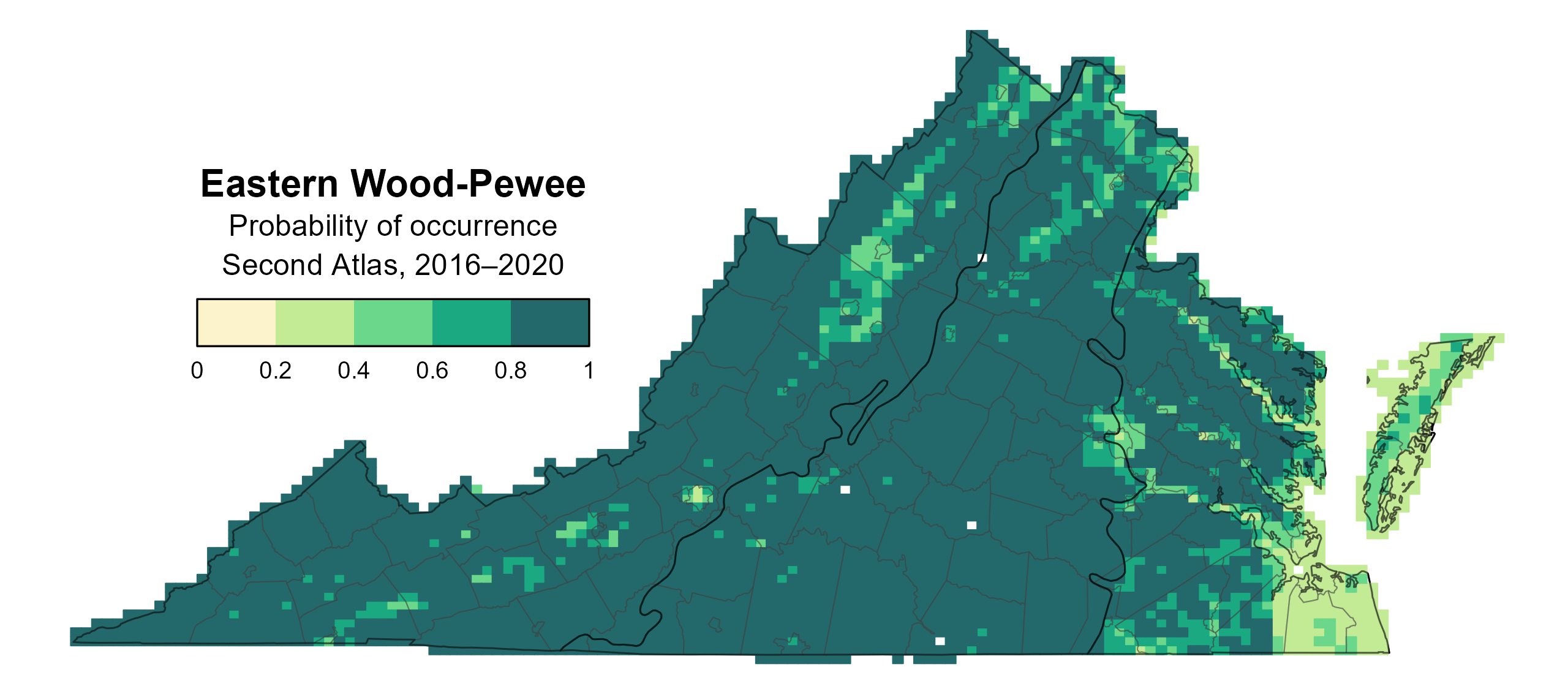
Figure 1: Eastern Wood-Pewee breeding distribution based on probability of occurrence (Second Atlas, 2016–2020). This map indicates the probability that this species will occur in an Atlas block (an approximately 10 mi2 [26 km2] survey unit) based on environmental (including habitat) factors and after adjusting for the probability of detection (variation in survey effort among blocks).
Breeding Evidence
Eastern Wood-Pewees were confirmed breeders in 289 blocks and 89 counties and found to be probable breeders in an additional 22 counties (Figure 2). Although fewer in number, breeding observations were recorded throughout the state during the First Atlas as well (Figure 3). However, it is important to note that survey effort was greater during the Second Atlas.
Breeding evidence was documented from early May to the end of September. Breeding was primarily confirmed through observations of occupied nests (May 7 – July 29), adults carrying food (May 19 – August 16), adults feeding young (June 7 – September 1), and recently fledged young (June 1 – September 18) (Figure 4).
For more general information on the breeding habits of this species, please refer to All About Birds.
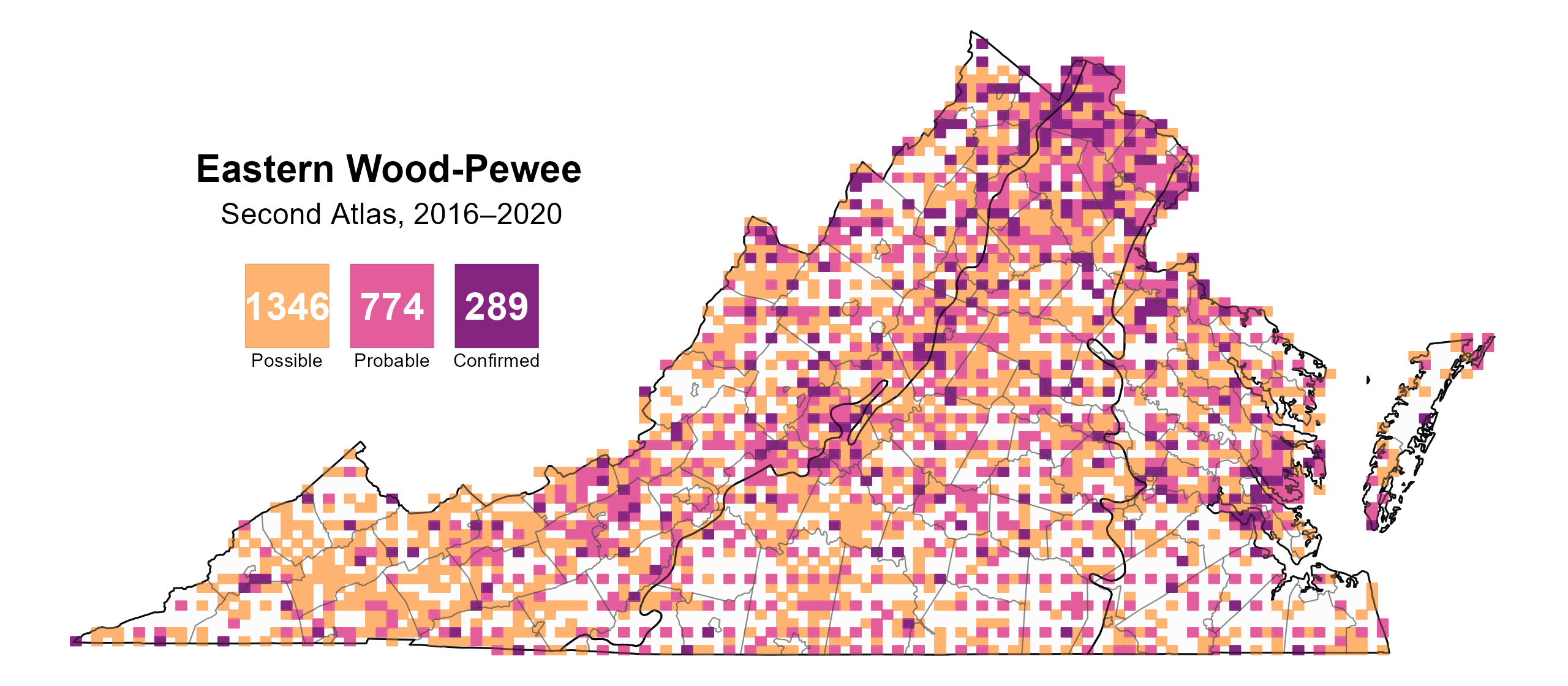
Figure 2: Eastern Wood-Pewee breeding observations from the Second Atlas (2016–2020). The colored boxes illustrate Atlas blocks (approximately 10 mi2 [26 km2] survey units) where the species was detected. The colors show the highest breeding category recorded in a block. The numbers within the colors in the legend correspond to the number of blocks with that breeding evidence category.
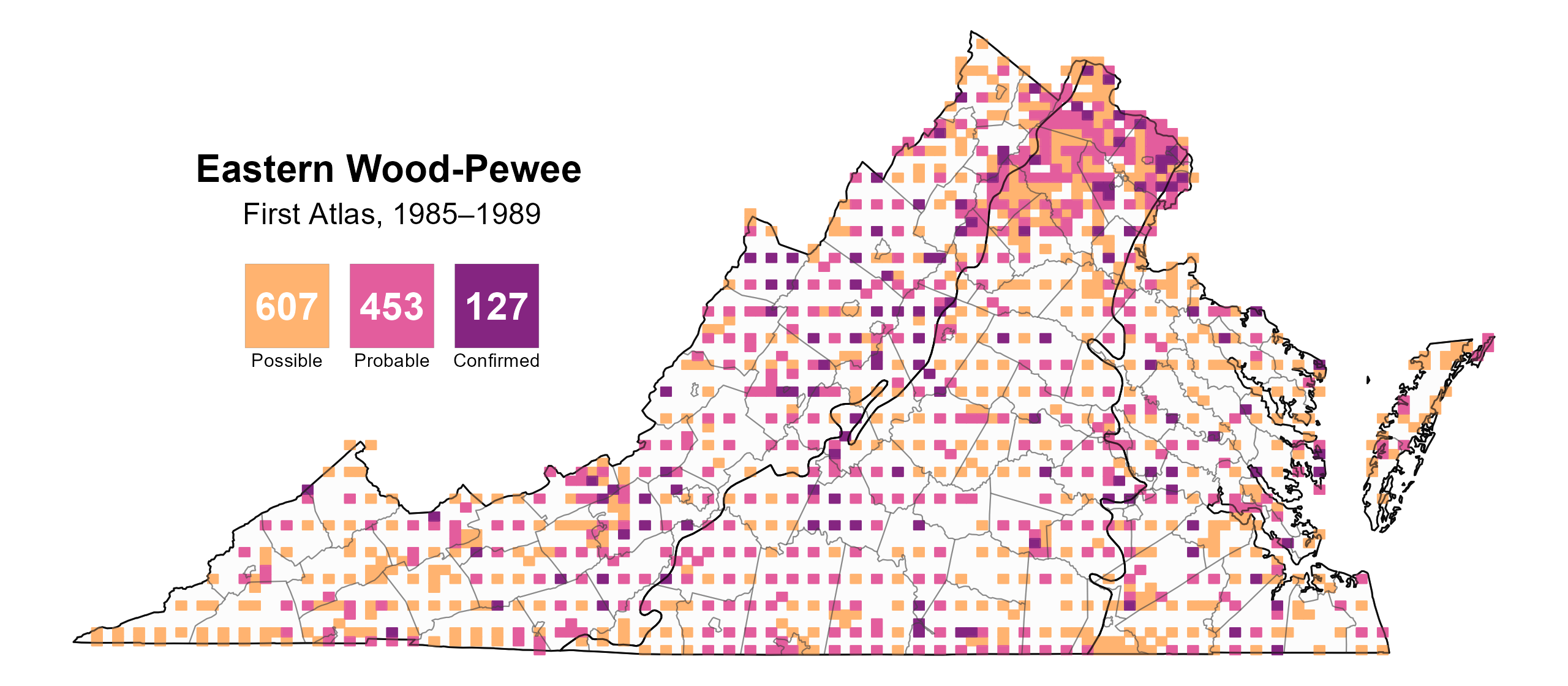
Figure 3: Eastern Wood-Pewee breeding observations from the First Atlas (1985–1989). The colored boxes illustrate Atlas blocks (approximately 10 mi2 [26 km2] survey units) where the species was detected. The colors show the highest breeding category recorded in a block. The numbers within the colors in the legend correspond to the number of blocks with that breeding evidence category.
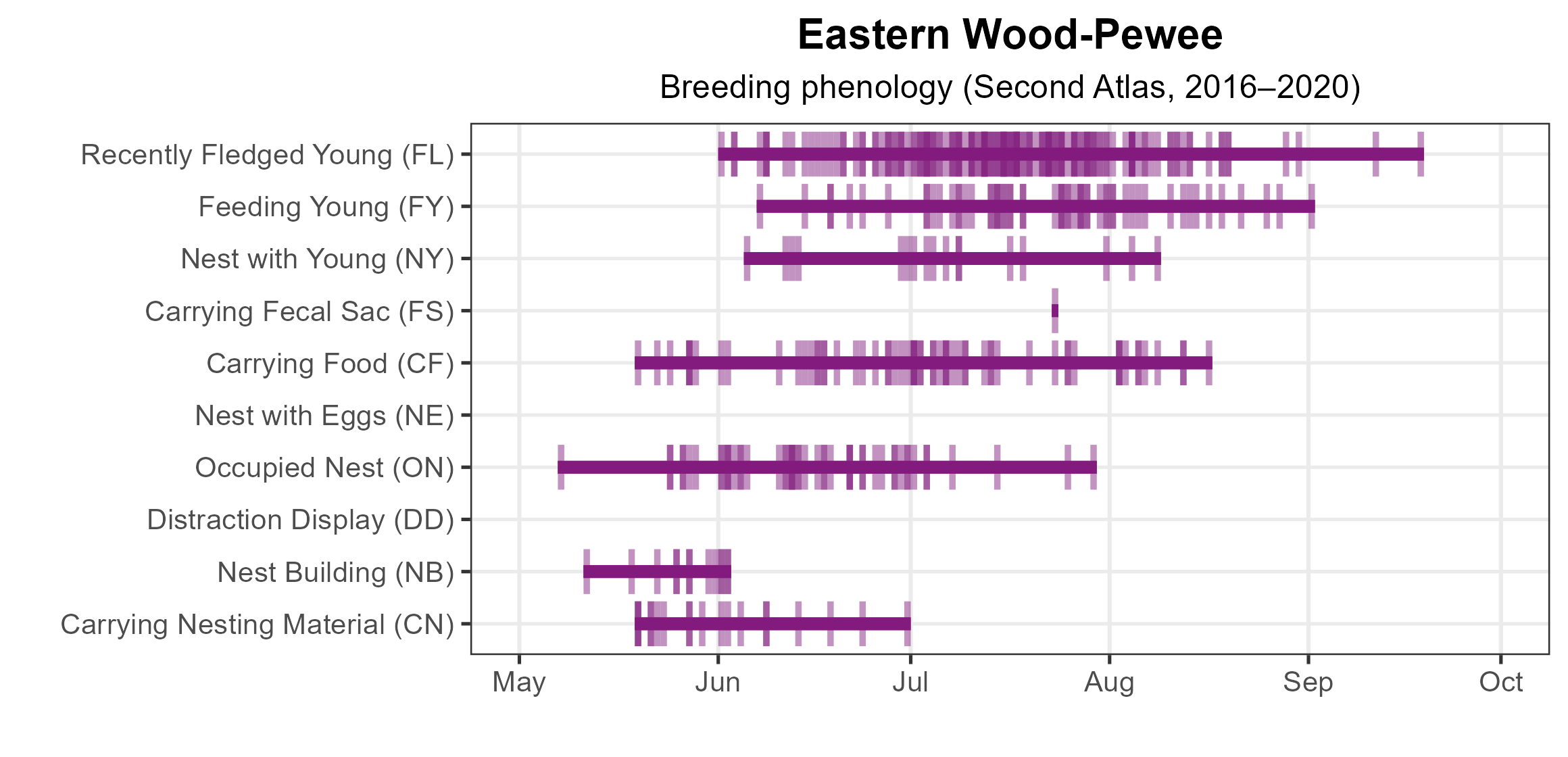
Figure 4: Eastern Wood-Pewee phenology: confirmed breeding codes. This graph shows a timeline of confirmed breeding behaviors. Tick marks represent individual observations of the behavior.
Population Status
Eastern Wood-Pewee relative abundance was estimated to be highest in the northern Blue Ridge Mountains, the central Piedmont region, and the riparian forests of the Coastal Plain. Predicted abundance was lower in the Shenandoah Valley and other agricultural areas, urban landscapes, and coastal locations with limited forest cover (Figure 5).
The total estimated Eastern Wood-Pewee population in the state is approximately 842,000 individuals (with a range between 632,000 and 1,128,000). Based on the North American Breeding Bird Survey (BBS), the Eastern Wood-Pewee population declined by a significant 1.21% annually from 1966–2022 in Virginia, and between Atlases, its population declined by a significant 1.38% per year from 1987–2018 (Hostetler et al. 2023; Figure 6).
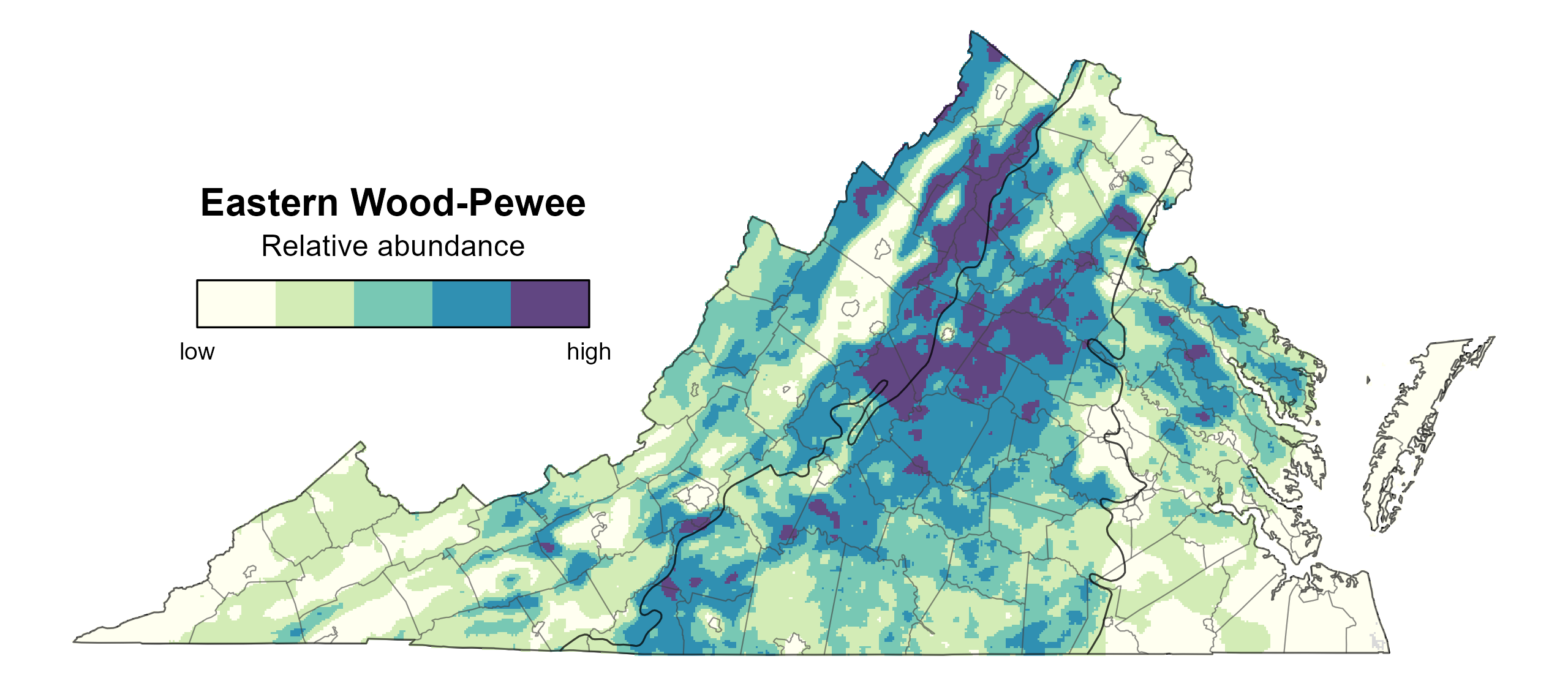
Figure 5: Eastern Wood-Pewee relative abundance (Second Atlas, 2016–2020). This map indicates the predicted abundance of this species at a 0.4 mi2 (1 km2) scale based on environmental (including habitat) factors. Abundance values are presented on a relative scale of low to high.
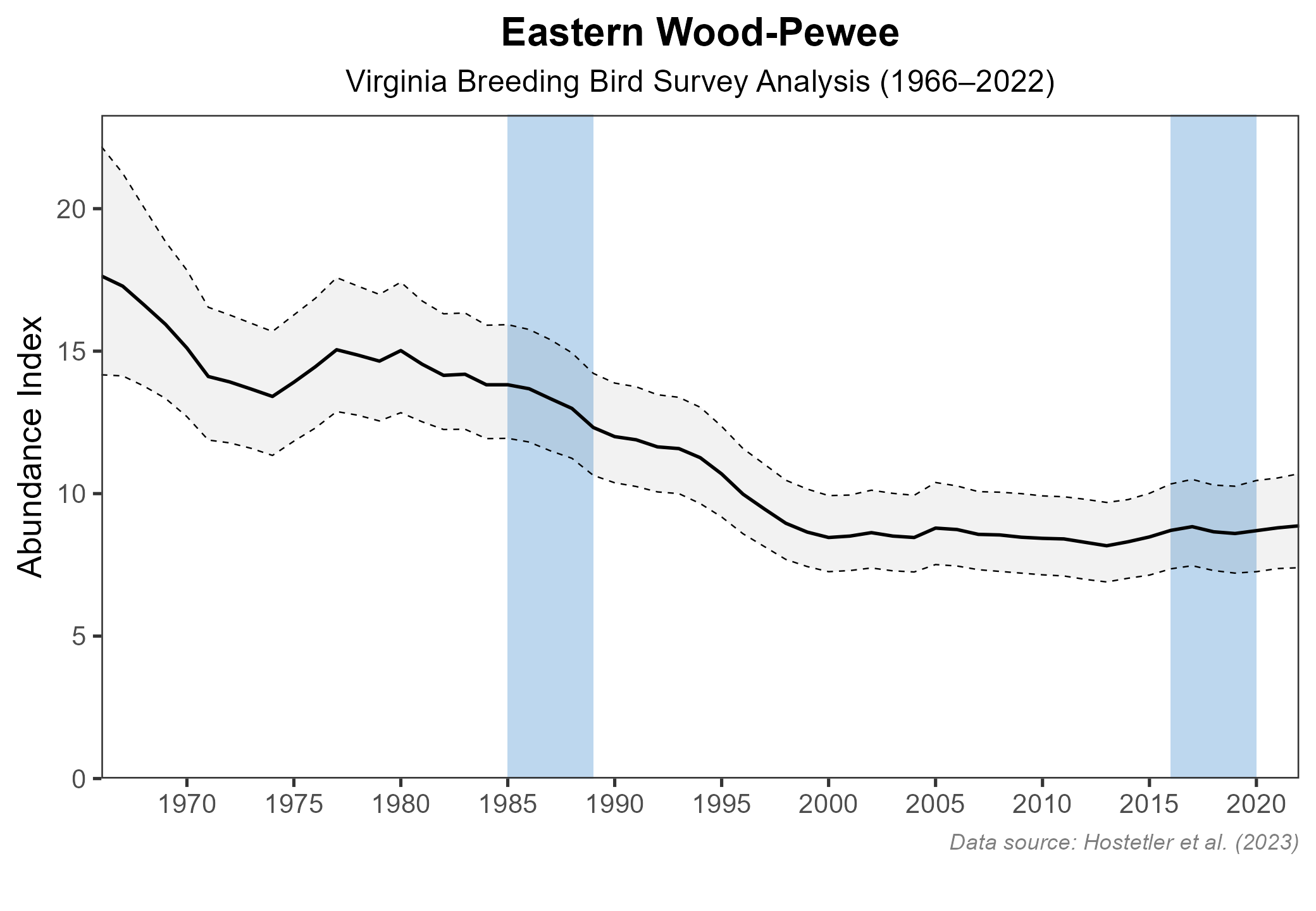
Figure 6: Eastern Wood-Pewee population trend for Virginia as estimated by the North American Breeding Bird Survey. The vertical axis shows species abundance; the horizontal axis shows the year. The solid line indicates the estimated population trend; there is a 97.5% probability that the true population trend falls between the dashed lines. The shaded bars indicate the First and Second Atlas periods.
Conservation
Although the Eastern Wood-Pewee is a relatively common and widespread bird in Virginia and throughout its range, it has experienced a decline in the state. For populations in the Northeast and Mid-Atlantic regions, high white-tailed deer densities are cited as one potential cause for the declines. Over-browsing by white-tailed deer reduces forest understory structure, which is needed by Eastern Wood-Pewees for foraging (DeCalesta 1994; Rushing et al. 2020). In Virginia, the 2025 Wildlife Action Plan classifies this species as a Tier IV Species of Greatest Conservation Need (Moderate Conservation Need), indicating that conservation planning efforts are needed (VDWR 2025).
Interactive Map
The interactive map contains up to six Atlas layers (probability of occurrence for the First and Second Atlases, change in probability of occurrence between Atlases, breeding evidence for the First and Second Atlases, and abundance for the Second Atlas) that can be viewed one at a time. To view an Atlas map layer, mouse over the layer box in the upper left. County lines and physiographic regional boundaries (Mountains and Valleys, Piedmont, and Coastal Plain) can be turned on and off by checking or unchecking the box below the layer box. Within the map window, users can hover on a block to see its value for each layer and pan and zoom to see roads, towns, and other features of interest that are visible beneath a selected layer.
View Interactive Map in Full Screen
References
DeCalesta, D. S. (1994). Effects of white-tailed deer on songbirds within managed forests in Pennsylvania. Journal of Wildlife Management 58:711-718.
Hostetler, J. A., J. R. Sauer, J. E. Hines, D. Ziolkowski, and M. Lutmerding (2023). The North American breeding bird survey, analysis results 1966–2022. U.S. Geological Survey, Laurel, MD, USA. https://doi.org/10.5066/P9SC7T11.
Rushing, C. S., R. W. Rohrbaugh, C. J. Fiss, C. S. Rosenberry, A. D. Rodewald, and J. L. Larkin (2020). Long-term variation in white-tailed deer abundance shapes landscape-scale population dynamics of forest-breeding birds. Forest Ecology and Management 456. https://doi.org/10.1016/j.foreco.2019.117629.
Virginia Department of Wildlife Resources (VDWR). 2025. Virginia wildlife action plan. Virginia Department of Wildlife Resources, Henrico, VA, USA. 506 pp.
Watt, D. J., J. P. McCarty, S. W. Kendrick, F. L. Newell, and P. Pyle (2020). Eastern Wood-Pewee (Contopus virens), version 1.0. In Birds of the World (P. G. Rodewald, Editor). Cornell Lab of Ornithology, Ithaca, NY, USA. https://doi.org/10.2173/bow.eawpew.01.





